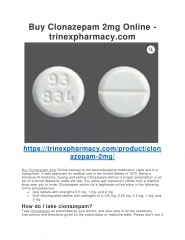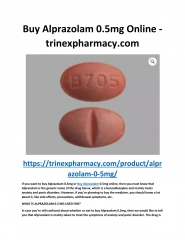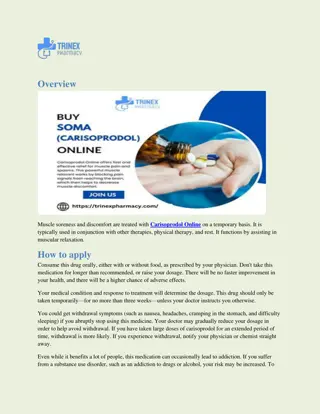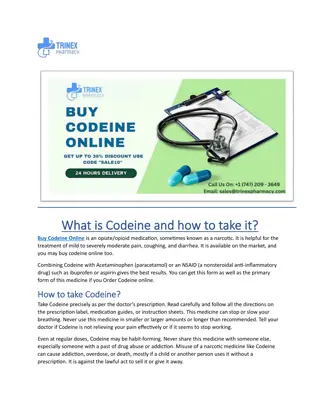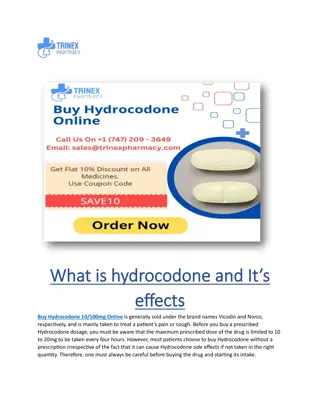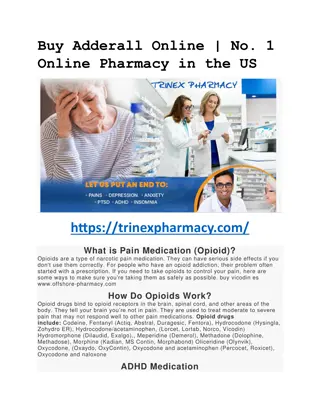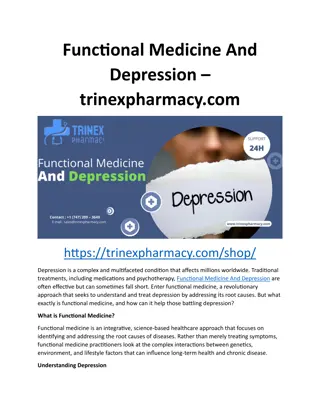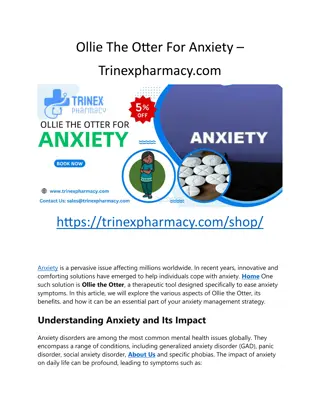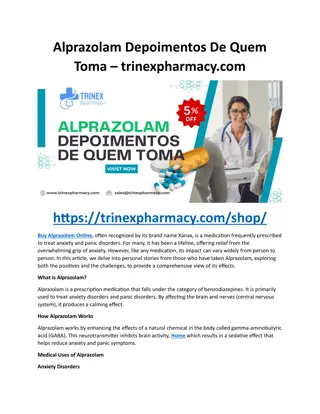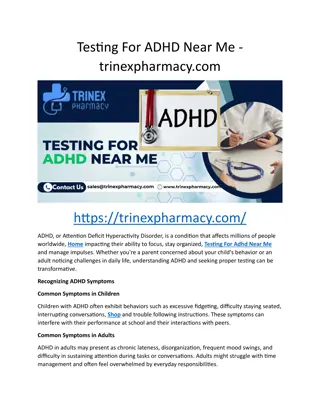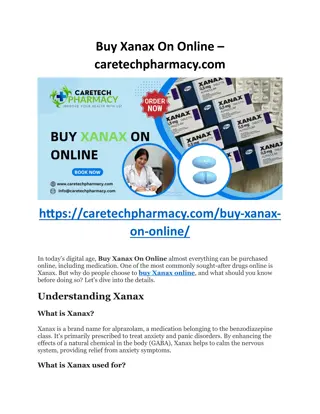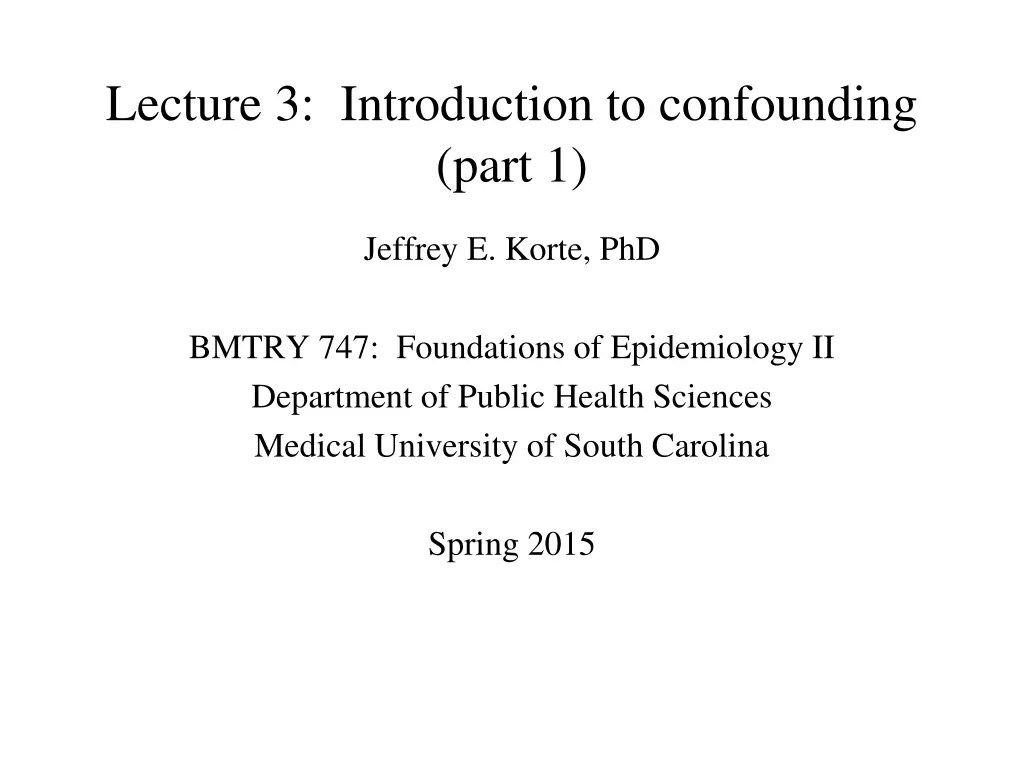
Understanding Confounding in Observational Research
Exploring the concept of confounding in observational research, this content delves into how confounders, whether known or unknown, can impact the association between exposure and outcome. It discusses the importance of avoiding bias and confounding in epidemiology to more fully comprehend the relationships between risk factors and health outcomes. The role of exchangeability in addressing confounding is also highlighted.
Download Presentation

Please find below an Image/Link to download the presentation.
The content on the website is provided AS IS for your information and personal use only. It may not be sold, licensed, or shared on other websites without obtaining consent from the author. If you encounter any issues during the download, it is possible that the publisher has removed the file from their server.
You are allowed to download the files provided on this website for personal or commercial use, subject to the condition that they are used lawfully. All files are the property of their respective owners.
The content on the website is provided AS IS for your information and personal use only. It may not be sold, licensed, or shared on other websites without obtaining consent from the author.
E N D
Presentation Transcript
Lecture 3: Introduction to confounding (part 1) Jeffrey E. Korte, PhD BMTRY 747: Foundations of Epidemiology II Department of Public Health Sciences Medical University of South Carolina Spring 2015
Observational research Studies with no selection or information bias may still suffer from confounding Confounding is a type of bias Produces an observed association different from the true association you are looking for But confounding is different Does not result from a problem with study design or execution Reflects complex relationships among multiple factors: the reality of observational research The web of causation
Observational research Confounders may be known or unknown Known confounders might (or might not) be measured in your study To be a confounder, a factor must be associated with both the exposure and the outcome of interest.
Observational research Avoiding bias and confounding drives much of what we do in epidemiology Goal: to more fully understand the relationships between risk factors and health outcomes Could be: adjusted relationship (out of context) Could be: relationship in the context of other concurrent factors
Confounding variable exposure disease confounder
Confounding variable Produces a change in the observed association between exposure and disease Confounder may: Inflate the association (or cause an association to appear) Decrease the association (or cause it to vanish) This occurs because confounder is related to disease, and is distributed differently between exposure groups
Exchangeability The two comparison groups should theoretically be exchangeable with respect to all factors other than the exposure of interest This can only be achieved in a randomized controlled trial Lack of exchangeability leads to confounding
Example: alcohol and lung cancer (heavy drinkers) Dis Not dis Exp 31 369 400 No exp 79 1521 1600 110 1890 2000 RR=(31/400)/(79/1600)=1.6
Example: alcohol and lung cancer crude RR=(31/400)/(79/1600)=1.6 Dis Not dis Dis Not dis Exp 1 99 100 Exp 30 270 300 No exp 9 891 900 No exp 70 630 700 10 990 1000 100 900 1000 Non-smokers: RR=1.0 Smokers: RR=1.0
Example: alcohol and lung cancer Rates of heavy drinking: Smokers: Non-smokers: 10% Rates of lung cancer: Smokers: Non-smokers: 1% No association between alcohol and lung cancer, after stratifying by smoking status Conclusion: association is confounded by smoking 30% 10%
Smoking and lung cancer (same data, rearranged) Dis Not dis Dis Not dis Exp 70 630 700 Exp 30 270 300 No exp 9 891 900 No exp 1 99 100 79 1521 1600 31 369 400 Non-drinkers: RR=10 Drinkers: RR=10
Smoking and lung cancer (same data, rearranged) RR = ((100/1000) / (10/1000) = 10 Dis Not dis Exp 100 900 1000 Stratified associations are identical to crude association Conclusion: no confounding by alcohol drinking No exp 10 990 1000 110 1890 2000
Example: alcohol and lung cancer (heavy drinkers) Unadjusted: Alcohol-lung cancer RR=1.6 Smoking-lung cancer RR=10 Adjusted: Alcohol-lung cancer RR=1.0 Smoking-lung cancer RR=10
Example: alcohol and lung cancer (heavy drinkers) Conclusion 1: Smoking is a confounder of alcohol-lung cancer association, because: Smoking is unevenly distributed between drinkers and non-drinkers, AND Smoking is a cause of lung cancer unevenly distributed : same thing as saying that smoking is associated with drinking
Example: alcohol and lung cancer (heavy drinkers) Conclusion 1: Smoking is a confounder of alcohol-lung cancer association, because: Smoking is unevenly distributed between drinkers and non-drinkers, AND Smoking is a cause of lung cancer unevenly distributed : same thing as saying that smoking is associated with drinking
Alcohol and lung cancer ? alcohol lung cancer
Alcohol and lung cancer X alcohol lung cancer smoking
Example: alcohol and lung cancer (heavy drinkers) Conclusion 2: Alcohol drinking is not a confounder of smoking-lung cancer association, because: Drinking is unevenly distributed between smokers and non-smokers, BUT Drinking is not a cause of lung cancer
Smoking and lung cancer ? smoking lung cancer
Smoking and lung cancer smoking lung cancer X alcohol
Example: alcohol and lung cancer (heavy drinkers) Conclusion 3: Confounding is not reciprocal in this case Smoking confounds alcohol-lung cancer association: Crude RR: 1.6 Stratified RRs: 1.0 in smokers, 1.0 in non-smokers But alcohol does not confound smoking-lung cancer association: Crude RR: 10.0 Stratified RRs: 10.0 in drinkers, 10.0 in non-drinkers
Example: alcohol and lung cancer (heavy drinkers) Conclusion 4: There is no effect modification Stratified RRs for alcohol-lung cancer: 1.0 in smokers, 1.0 in non-smokers Stratified RRs for smoking-lung cancer: 10.0 in drinkers, 10.0 in non-drinkers By the way, effect modification is always reciprocal (confounding can be reciprocal, but is not in this example)
Example: alcohol and lung cancer (heavy drinkers) Lung cancer rates: Smokers who drink: Smokers who don t drink: 30/300 = 10% 70/700 = 10% Non-smokers who drink: Non-smokers who don t drink: 9/900 = 1% 1/100 = 1%
Example: alcohol and lung cancer (heavy drinkers) How would this example look if the study had been a randomized controlled trial? With sufficient sample size, RCTs should be free of confounding Equal distribution of all risk factors between exposure groups (the only difference between the groups is the exposure: this is perfect exchangeability)
Example: alcohol and lung cancer (randomized controlled trial) Dis Not dis Dis Not dis Exp 7 693 700 Exp 30 270 300 No exp 7 693 700 No exp 30 270 300 14 1386 1400 60 540 600 Non-smokers: RR=1.0 Smokers: RR=1.0
Example: alcohol and lung cancer (randomized controlled trial) Dis Not dis Relative risk: (37/1000) / (37/1000) Exp 37 963 1000 No exp 37 963 1000 =1.0 74 1926 2000
Example: alcohol and lung cancer (randomized controlled trial) Conclusion: no confounding Crude RR = (37/1000) / (37/1000) = 1.0 Stratified RRs: Smokers RR=1.0 Non-smokers RR=1.0 Adjusted RR has to be 1.0 weighted average of 1.0 and 1.0
Example: alcohol and lung cancer (heavy drinkers) How would this example look if the study had been a matched case-control study? Matching is another way to control confounding through study design Equal distribution of matched risk factors between cases and controls (confounding is impossible if the potential confounder is forced to be equally distributed)
Example: alcohol and lung cancer (matched case-control study) Dis Not dis Dis Not dis Exp 70 70 140 Exp 90 90 180 No exp 630 630 1260 No exp 210 210 420 700 700 1400 300 300 600 Non-smokers: OR=1.0 Smokers: OR=1.0
Example: alcohol and lung cancer (matched case-control study) Dis Not dis Odds ratio: Exp 160 160 320 (160/840) / (160/840) No exp 840 840 1680 = 1.0 1000 1000 2000
Example: alcohol and lung cancer (matched case-control study) Conclusion: no confounding Crude OR = (160/840) / (160/840) = 1.0 Stratified ORs: Smokers RR=1.0 Non-smokers RR=1.0 Adjusted OR has to be 1.0 Weighted average of 1.0 and 1.0
Summary: how to control confounding Design Matching Randomized study Analysis Stratification Multivariate modeling
Caution: what if the confounder is on the causal pathway? (example 1) ? alcohol lung cancer ? smoking
Caution: what if the confounder is on the causal pathway? (example 2) ? # sexual partners cervical cancer ? HPV
Caution: what if the confounder is on the causal pathway? Discuss Schiffman et al 1993; JNCI 85(12):958-64 Discuss Safaeian et al 2010; JNCI 102(23):1794-1804

